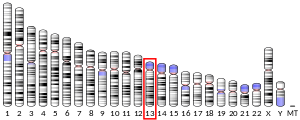From Wikipedia, the free encyclopedia
Protein-coding gene in the species Homo sapiens
Beta-1,3-glucosyltransferase is an enzyme that in humans is encoded by the B3GALTL gene .[ 5] [ 6] [ 7] [ 8]
^ a b c GRCh38: Ensembl release 89: ENSG00000187676 – Ensembl , May 2017^ a b c GRCm38: Ensembl release 89: ENSMUSG00000051950 – Ensembl , May 2017^ "Human PubMed Reference:" . National Center for Biotechnology Information, U.S. National Library of Medicine .^ "Mouse PubMed Reference:" . National Center for Biotechnology Information, U.S. National Library of Medicine .^ Heinonen TY, Pasternack L, Lindfors K, Breton C, Gastinel LN, Maki M, et al. (Aug 2003). "A novel human glycosyltransferase: primary structure and characterization of the gene and transcripts". Biochem Biophys Res Commun . 309 (1): 166– 174. doi :10.1016/S0006-291X(03)01540-7 . PMID 12943678 . ^ Sato T, Sato M, Kiyohara K, Sogabe M, Shikanai T, Kikuchi N, et al. (Nov 2006). "Molecular cloning and characterization of a novel human beta1,3-glucosyltransferase, which is localized at the endoplasmic reticulum and glucosylates O-linked fucosylglycan on thrombospondin type 1 repeat domain" . Glycobiology . 16 (12): 1194– 1206. doi :10.1093/glycob/cwl035 PMID 16899492 . ^ Kozma K, Keusch JJ, Hegemann B, Luther KB, Klein D, Hess D, et al. (Nov 2006). "Identification and characterization of abeta1,3-glucosyltransferase that synthesizes the Glc-beta1,3-Fuc disaccharide on thrombospondin type 1 repeats" . J Biol Chem . 281 (48): 36742– 36751. doi :10.1074/jbc.M605912200 PMID 17032646 . ^ "Entrez Gene: B3GALTL beta 1,3-galactosyltransferase-like" .
Strausberg RL, Feingold EA, Grouse LH, Derge JG, Klausner RD, Collins FS, et al. (2003). "Generation and initial analysis of more than 15,000 full-length human and mouse cDNA sequences" . Proc. Natl. Acad. Sci. U.S.A . 99 (26): 16899– 16903. Bibcode :2002PNAS...9916899M . doi :10.1073/pnas.242603899 PMC 139241 PMID 12477932 . Ota T, Suzuki Y, Nishikawa T, Otsuki T, Sugiyama T, Irie R, et al. (2004). "Complete sequencing and characterization of 21,243 full-length human cDNAs" . Nat. Genet . 36 (1): 40– 45. doi :10.1038/ng1285 PMID 14702039 . Dunham A, Matthews LH, Burton J, Ashurst JL, Howe KL, Ashcroft KJ, et al. (2004). "The DNA sequence and analysis of human chromosome 13" . Nature . 428 (6982): 522– 528. Bibcode :2004Natur.428..522D . doi :10.1038/nature02379 . PMC 2665288 PMID 15057823 . Gerhard DS, Wagner L, Feingold EA, Shenmen CM, Grouse LH, Schuler G, et al. (2004). "The status, quality, and expansion of the NIH full-length cDNA project: the Mammalian Gene Collection (MGC)" . Genome Res . 14 (10B): 2121– 2127. doi :10.1101/gr.2596504 . PMC 528928 PMID 15489334 . Kimura K, Wakamatsu A, Suzuki Y, Ota T, Nishikawa T, Yamashita R, et al. (2006). "Diversification of transcriptional modulation: large-scale identification and characterization of putative alternative promoters of human genes" . Genome Res . 16 (1): 55– 65. doi :10.1101/gr.4039406 . PMC 1356129 PMID 16344560 . Lesnik Oberstein SA, Kriek M, White SJ, Kalf ME, Szuhai K, Den Dunnen JT, et al. (2006). "Peters Plus syndrome is caused by mutations in B3GALTL, a putative glycosyltransferase" . Am. J. Hum. Genet . 79 (3): 562– 566. doi :10.1086/507567 . PMC 1559553 PMID 16909395 .




